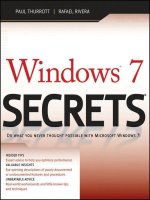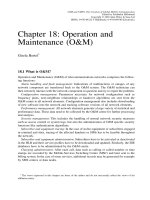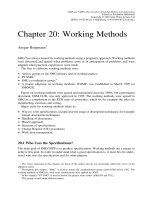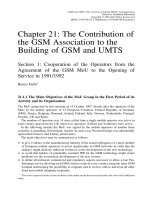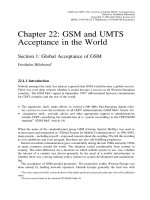Tài liệu GSM and UMTS (P1) docx
Bạn đang xem bản rút gọn của tài liệu. Xem và tải ngay bản đầy đủ của tài liệu tại đây (151.69 KB, 10 trang )
Chapter 1: GSM’s Achievements
Section 1: Introduction
Friedhelm Hillebrand
1.1.1 Introduction to the Content of the Book
This book describes how global mobile communication was made. It is written for those who
want or need to know how this was achieved e.g.:
† Young professionals who want to build their career on GSM and UMTS and need to
understand the basics
† Strategic and technical planners who want to drive the future GSM and UMTS develop-
ment
† Strategists who plan to repeat GSM’s success in the fourth generation
† Academics, who want to understand and analyse the development of GSM and UMTS;
† Activists in other large scale international communication projects who want to use
experiences gained
But the book is also written for those about two thousand colleagues who participated in
the work and want to have a record of the events or to have a more comprehensive image, of
what happened in the different branches of the very big network of groups.
GSM is the system which started in Europe and was accepted by the world. It provides
global mobile communication to:
† anybody: 500 million users from professionals to children in May 2001
† anywhere: 168 countries in all continents in May 2001
† any media: voice, messaging, data, multimedia
UMTS is built on the GSM footprint and plans to repeat the GSM success.
This book is focused on the pre-competitive sphere, the big co-operative effort, which
enabled the huge market success world-wide. The clarification of the strategies, the strategic
decisions on the broad avenues in service and system design and commercial concepts are
described. This book provides an insight into the process of how this was achieved and when.
In selected cases it shows the complexity of the process and the antagonism of the interests of
the different parties and the consensus building process in detail. The output of the process is
well documented in the technical specifications produced by the different groups. They can be
retrieved from the Internet.
1
1
www.ETSI.org, www.3GPP.org, www.gsmworld.org or www.umtsforum.org. The GSM phase 1 standard can be
found on the attached CD ROM in folder A3, since it is not available from the Internet.
GSM and UMTS: The Creation of Global Mobile Communication
Edited by Friedhelm Hillebrand
Copyright q 2001 John Wiley & Sons Ltd
ISBNs: 0-470-84322-5 (Hardback); 0-470-845546 (Electronic)
This book describes the building of the will and momentum to create a Pan-European
system to end the market segmentation and barriers to growth. Principles were agreed.
Advanced services’ requirements including international roaming were agreed. To fulfil
these requirements an advanced new digital system was developed. The system provided
for a competition of several operators in a country. Advanced low cost terminals were
achieved by large markets and manufacturers competition. Advanced low cost infrastructure
was enabled by large markets, multivendor concepts and manufacturers competition. All
major decisions were made in time, even the most difficult ones. A far-reaching system
evolution – even leading from second to third generation – was implemented. Manufacturers
and operators promoted GSM in Europe and beyond. The world was invited to become a
partner with equal rights in this process.
The book covers intensively the two phases which lead to the long-term strategic orienta-
tion of GSM and UMTS. There were protracted and deep controversial debates, which lead to
a consensus:
† The debate about the concepts and the basic parameters of the GSM standard from the end
of 1986 to mid-1987 showed that the Europeans could agree on one solution and meant
business with GSM. It lead to the creation of a new more open organisation by moving all
work from CEPT GSM to ETSI GSM opening the doors for manufacturers to participate
with equal rights and the GSM MoU Group to participate as the operators’ club.
† The debate about the strategy, the concepts and the basic parameters of UMTS in 1996–
1997 lead to a re-orientation of the UMTS concept and an agreement on its cornerstones
within ETSI and with key players in North America and in Asia. This required also a new
more open and more efficient organisation of the work in 3GPP, which allowed access
with equal rights to non-European players.
In both cases a stable base and framework for the following phase of more detailed work
was achieved.
The much more competitive situation in the market created by the licensing of several
operators in a country did in principle not deteriorate the consensus building process, since
the new players understood very quickly that a constructive co-operation in the pre-compe-
titive sphere was the prerequisite of the success. These new players brought often more
demanding requirements. This was essential for the vivid and fertile system evolution.
The founding documents of the GSM/UMTS system are the GSM/UMTS Technical Speci-
fications and Standards and the Permanent Reference Documents (PRDs). The Technical
Specifications contain the basic technical definitions: services, system architecture, selected
interfaces and operation and maintenance functions, and test specifications. Some of these,
which are needed for regulatory purposes, are converted into formal Standards. The Tech-
nical Specifications and Standards were elaborated by groups who varied over time: CEPT
GSM, ETSI GSM and SMG, ANSI T1P1 and 3GPP. The PRDs cover commercial and
operational aspects, e.g. service and commercial requirements, test specifications for roam-
ing, security algorithms, protocols for the interchange of charging data for roamers. They
were elaborated by working groups in the GSM MoU Group, later called GSM MoU Asso-
ciation and now GSM Association.
The book provides in the rest of Chapter 1 key milestones and success statistics. It
describes in Chapters 2–9 the GSM phases and the evolution towards UMTS built on
GSM. Chapters 10–20 provide more details on technical aspects and working methods.
GSM and UMTS: The Creation of Global Mobile Communication2
Chapter 21 deals with operators co-operation and the elaboration of the PRDs. Chapter 22
describes the world-wide acceptance of GSM and UMTS. Chapter 23 tries to explain from
our point of view, which factors enabled this success which surpassed all expectations. A CD-
ROM is attached to the book, which contains all reference documents mentioned in the
footnotes of the different contributions.
The success of GSM and UMTS was created by the working together of a very large
number of people in a network. The catalyst of this process was the co-operation of a smaller
number of people in the pre-competitive sphere using different forums. All these colleagues
created the technical system specifications for GSM and UMTS and the technical and
commercial documents needed for the marketing and operation of GSM and UMTS with
special emphasis on international roaming. All these people worked in a network. They
shared visions and strategy. It was for all of them a privilege to have the opportunity to
contribute to this ‘‘ inner circle’’ .
The book is structured into contributions, which are written as named contributions by key
players who played a long-term key role in the development of GSM and UMTS. The views
expressed in the different contributions are those of the authors and do not necessarily reflect
the views of their respective affiliation entities. There has been a lot of dialogue between all
authors during the writing of the book. However, it was the intention to provide different
views from different perspectives to the reader. We did not try to iron out all differences of
opinion. The book shows how different personalities could work together like a big orchestra,
create and play a great symphony. In selected cases the reader will find cross references by the
editor in footnotes highlighting to key differences. It is a major achievement of this book that
so many people – despite their loaded agenda took the time to report about their experiences
and views.
It was a pleasure for me to act as editor of this book and work together with so many
excellent colleagues to provide this record of events and our explanations. We are open to
dialogue with our readers. Our CVs and e-mail addresses are provided in the attached CD
ROM File G.
1.1.2 Practical Advice on how to use the Book
The content list is structured into chapters and sections containing the individual contribu-
tions written by named authors. A short CV and e-mail address of each author is provided in
the attached CD ROM file G. All footnotes in a contribution are numbered locally.
The decision making plenary meetings changed over time from GSM (Groupe Spe
´
cial
Mobil) to SMG (Special Mobile Group) to 3GPP TSG SA (Technical Specification Group
Services and System Aspects). The Plenary meetings are numbered in sequence: GSM#1 to
32, SMG#1 to 32 and SA#1
Similarly the subgroups reporting to the plenary changed their names. The group
responsible for services was WP1 (Working Party), then GSM1, then SMG1 and finally
TSG SA WG SA1. Equal developments had the radio groups using the number 2 and the
network aspects group using the number 3. The data group started as IDEG and became
GSM4 and SMG4.
Reference documents, which are relevant and often difficult to retrieve are provided on
the attached CD-ROM. Reference documents are mentioned in footnotes in the sections. The
Chapter 1: GSM’s Achievements 3
vast majority are temporary documents of the different standardisation groups. Their number
contains a serial number and a year number. Often the format is SSS/YY (e.g. 123/87 ¼
temporary document 123 of 1987). This was changed in later years to YY-SSS. The CD-
ROM uses file names of uniform format with the year followed by the serial number for an
easy automatic sorting. The CD-ROM provides the quoted reference documents and all
Plenary Meeting Reports of the technical standardisation groups: CEPT, ETSI GSM and
SMG and 3GPP. In addition key documents of other areas are provided e.g. the GSM
Memorandum of Underatanding and the UMTS Task Force report. Finally a folder F contains
funny things and a video and some photographs. More details are given in the contents list of
the CD-ROM in the file ‘‘ Introduction’’ .
Several overview lists and descriptions are provided:
† Milestones: Chapter 1, Section 2
† Plenary Meeting Lists in Annex 1
† Technical groups and their evolution in Annex 2
† Chairpersons lists in Annex 3
† Key abbreviations in Annex 4
The current version of the complete GSM and UMTS Specifications can be found at the
following website: www.3gpp.org. The GSM Phase 1 specifications of 1990/1 can be found
on the attached CD-ROM in folder A3.
GSM and UMTS: The Creation of Global Mobile Communication4
Chapter 1: GSM’s Achievements
Section 2: GSM and UMTS Milestones
Friedhelm Hillebrand
1982 CEPT allocates 900 MHz spectrum for the use by a Pan-European mobile communication
system, forms the ‘‘Groupe Spe
´
cial Mobile’’ (GSM) and recommends the reservation of
frequencies in the 900 MHz band for the future Pan-European cellular system.
1982 (December) First meeting of the Group Spe
´
cial Mobile (GSM) in Stockholm.
1984 (August) Decision of France and Germany to terminate the planned common 900 MHz analogue
system development and to concentrate on a standardised Pan-European digital system.
1986 (June) GSM Permanent Nucleus established in Paris.
1986 Trials of different digital radio transmission schemes and different speech codecs in several
countries, comparative evaluation by CEPT GSM in Paris.
1987 (February) CEPT GSM#13 meeting in Madeira: decision on the basic parameters of the GSM
system.
1987 (May) Finalisation of the decision on the basic parameters of the GSM system.
1987 (June) The European council agrees to the issue of a Directive reserving 900 MHz frequency
blocks.
1987 (7 September) GSM Memorandum of Understanding, an agreement to support the development of
GSM and to implement it in 1991, signed in Copenhagen by 14 operators from 13
European countries.
1988 (I Quarter) Completion of first set of detailed GSM specifications for infrastructure tendering
purposes.
1988 (29 February) Simultaneous issue of invitation to tender for networks by ten GSM network operators.
1988 Autumn Ten GSM infrastructure contracts signed by ten network operators.
1988 (October) Public presentation of the first set of GSM specifications at a conference in Hagen
(Germany), which attracts 600 participants from Europe, USA and Japan and where copies
of the specifications could be bought.
1989 Standardisation work transferred from CEPT to ETSI. CEPT Groupe Spe
´
cial Mobile
becomes ETSI Technical Committee GSM.
1990 GSM Phase 1 specifications ‘‘frozen’’ in ETSI Technical Committee GSM.
1991 GSM MoU Permanent Secretariat established in Dublin.
1991 (October) Pilot GSM networks demonstrated at ITU’s Telecom ‘91 in Geneva.
1991 (October) ETSI Technical Committee GSM put in charge of UMTS specification activities in addi-
tion to the GSM work and renamed ‘‘SMG’’ ( ¼ Special Mobile Group).
1991-1992 Search for a system name leads to ‘‘Global System for Mobile Communications’’.
1992 First commercial GSM networks come into service.
1992 (June) First true hand-portable terminals become available.
1992 (17 June) First international roaming agreement signed between the GSM networks of Telecom
Finland and the UK’s Vodafone.
1993 1 million GSM users.
GSM and UMTS: The Creation of Global Mobile Communication
Edited by Friedhelm Hillebrand
Copyright q 2001 John Wiley & Sons Ltd
ISBNs: 0-470-84322-5 (Hardback); 0-470-845546 (Electronic)
1993 Australian operators are first non-European operators who decide to implement
GSM and to sign the MoU.
1993 ETSI Technical Committee SMG agrees objectives and methodology for an open
evolution of GSM beyond phase 2, to be implemented as phase 2 1 .
1993 (September) The world’s first DCS 1800 (now GSM 1800) personal communication network opened in
the UK by Mercury One-2-One (now One 2 One).
1994 Data capabilities launched in GSM networks.
1995 (June) GSM MoU Group becomes a legal body, registered as a GSM MoU Association in
Switzerland.
1995 (Autumn) 10 million GSM users in 100 GSM networks on air in (60) countries world-wide
1995 (October) GSM Phase 2 standardisation frozen in ETSI Technical Committee SMG.
1995 (November) The first North American PCS 1900 (now GSM 1900) network opened by American
Personal Communications in Washington, DC.
1995 Fax, data and SMS services started, video over GSM demonstrated.
1996 (March) UMTS Task Force Report on a UMTS strategy for Europe completed.
1996 (Summer) PCS-1900 (now GSM 1900) service, provided to the US Republican National
Convention which was held in San Diego, CA.
1996 (Spring) Creation of the UMTS Forum as a world-wide body, dealing with market, regulation and
spectrum aspects of UMTS.
1996 (August) GSM MoU Association signs co-operation agreement with ETSI.
1996 DCS 1800 renamed GSM 1800 and PCS 1900 renamed GSM1900.
1997 (February) GSM release 96, the first release of phase 2 1 , completed by ETSI Technical Committee
SMG.
1997 (February) Consensus on UMTS strategy achieved by ETSI Technical Committee SMG.
1997 (Autumn) 100 countries on air (70 million users in 200 networks).
1997 (End) GSM release 97 completed by ETSI Technical Committee SMG.
1998 (I Quarter) Decision on the basic concepts of the UMTS standard including services, radio and
network aspects.
1998 (Mid) 100 million GSM users world-wide.
1998 (End) GSM release 98 completed by ETSI Technical Committee SMG.
1998 (December) Creation of the Third Generation Partnership Project (3GPP), transfer of the UMTS
standardisation work.
2000 (March) GSM/UMTS release 99, the basis for GSM evolution and UMTS opening in 2002,
completed by 3GPP and ETSI Technical Committee SMG and ANSI T1P1.
2000 (June) Transfer of the remaining GSM specification work to 3GPP, closing of ETSI Technical
Committee SMG, creation of a new Technical Committee MSG ( ¼ Mobile Standards
Group) responsible for European regulatory standards for terminals.
2001 (May) 500 million GSM users world-wide.
GSM and UMTS: The Creation of Global Mobile Communication6
Chapter 1: GSM’s Achievements
Section 3: GSM’s Success Measured in Numbers
Friedhelm Hillebrand
This section presents figures achieved in the years from 1992 to the end of 2000. It looks at
the values for GSM in total, i.e. GSM 900, 1800 and 1900.
1.3.1 GSM User Numbers World-wide
Figure 1.3.1 shows the explosive growth from 0.25 million in 1992 the first year of commer-
cial operation to 450 million at the end of 2000. The never expected number of 500 million
was passed in May 2001. A duplication to 1 billion users can be expected in 2005.
Figure 1.3.1 GSM user numbers world-wide
GSM and UMTS: The Creation of Global Mobile Communication
Edited by Friedhelm Hillebrand
Copyright q 2001 John Wiley & Sons Ltd
ISBNs: 0-470-84322-5 (Hardback); 0-470-845546 (Electronic)
1.3.2 GSM Networks and Countries on Air (Figure 1.3.2)
From the initial base of 13 networks in seven European countries in 1992 these figures grew
to 392 networks in 147 countries on all continents. International roaming connects all these
countries. This means that GSM is present in more countries than nearly all the famous mass
market brands like Coca Cola, McDonalds.
1.3.3 International Roaming
The GSM user enjoys a truly global infrastructure.
1
All GSM operators have international
roaming. The advanced operators have 100 or more roaming relations working. Every new
operator has typically after 6 months of operation at least ten roaming relations in operation.
In total more than 20 000 roaming agreements were concluded in Autumn 1999.
There were 40 operators, who have roaming with 70 or more countries, based on 5600
roaming agreements.
The roaming traffic exceeded the expectations. In August 1999 there were more than 400
million calls/month originated by roamers in visited networks. Many networks have 10% or
more of their traffic from roamers.
1.3.4 Short Message Service
The GSM Short Message Service is the first mobile data service that reached the mass market.
Mainly young people love to exchange text messages and little drawings. Large European
operators transmitted between 500 and 1000 million short messages in December 2000.
World-wide 50 billion short messages were sent in the first quarter of 2001 after 12 billion
in the first quarter of 2000 (source: GSMA)
GSM and UMTS: The Creation of Global Mobile Communication8
Figure 1.3.2 GSM networks and countries on air
1
Japan and Korea have not admitted GSM. Japan offers interstandard roaming GSM/PDC.
1.3.5 Competition with other Standards
The competition on the world market in the first half of the 1990s was mainly between GSM
and analogue systems since the other digital systems were either not available outside their
home market or not yet ready. In most developed market the digital systems dominated
clearly at the end of 2000. In Europe GSM serves 98% of the mobile users.
The competition between digital mobile systems took place mainly between four systems
(Table 1.3.1).
The competition lead to a clear decision in the world market. GSM served 69% of all
digital mobile users at the end of 2000 (Figure 1.3.3).
1.3.6 Forecasts and Reality in Europe
Compared to today’s reality in Europe, the mobile and wireless communications evolution
perspective of the world, at the beginning of 1985, looks retrospectively rather conservative.
While the promise of an accelerated development of mobile communications was sensed as a
likely possibility, due notably to the anticipated success of GSM, the most optimistic scenar-
ios for market deployment called for a few million subscribers at the turn of the century.
A famous study by a recognised consulting company
2
forecasted at the end of 1990 a total
number of 22.5 24.5 million mobile users in the year 2000 in Europe (European Union with
Chapter 1: GSM’s Achievements 9
Table 1.3.1 Four standards were ready for the world market competition in the early 1990s
System Radio Network Standard
GSM Advanced TDMA ISDN 1991
MAP
PDC Basic TDMA ISDN 1992
MAP
ANSI 54/136 TDMA Basic TDMA ANSI 41 evolution 1991
ANSI 95 CDMA Narrow band CDMA ANSI 41 evolution 1991
Figure 1.3.3 Competition in the world market
15 member states and Norway and Sweden). They expected that 18.5 21.3 million of them
would use GSM.
In the mid 90s, there were about 13 million users of mobile communications in Europe and
estimates suggested that the market potential would be of the order of 50 million at the turn of
the century and 100 million by 2005.
These forecasts are to be compared with the 245 million users (only 4 million of them still
on analogue systems, the rest on GSM) reached in Europe at the end of 2000.
Acknowledgements
All user figures were provided by EMC World Cellular Database. The figures on networks
and countries on air were provided by the GSM Association.
GSM and UMTS: The Creation of Global Mobile Communication10
2
‘‘ A study on the analysis of the introduction of GSM in the European Community’’ by PA Consulting, September
1990, commissioned by the Commission of the European Communities


